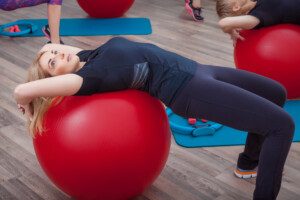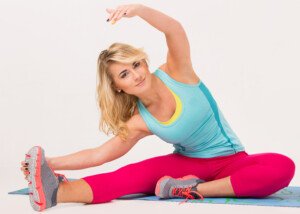Is your snapping hip syndrome finally on the mend, and you’re wondering what exercises can help prevent it from coming back?
Snapping hip syndrome is also called dancer’s hip, but it can affect athletes and fitness enthusiasts who conduct repetitive movements such as squats, deadlifts, hex bar work, climbing, running and hiking.
When the tendon becomes inflamed from overuse, it leads to pain with certain movements, such as abduction.
Abduction is when the legs move away from the midline of the body, as with the popular hip abduction machine that most gyms have.
“While stretching is an important part of managing snapping hip, unless you deal with the muscle imbalances that lead to the development of the problem in the first place, then you will continue to develop recurring pain,” says Dr. Megan McLain, PT, DPT, cofounder of Intuitive Choice Physical Therapy & Wellness in Atlanta, GA.
“These exercises should be used only under the guidance of a professional if you are having active snapping hip symptoms and will depend on the amount of irritation you are experiencing.”
Exercises that Can Help Prevent Snapping Hip Syndrome
Doing these exercises won’t guarantee that you won’t ever have a recurrence or a first time bout with this condition, but they can make the tendons in your hips sturdier, more stable and less likely to ever become inflamed.
Banded Sidestepping

Banded sidestepping
“Banded sidestepping helps to strengthen the musculature on the outside of the hip, which makes it more capable of handling loads,” says Dr. McLain.
“This prevents the IT band and hip flexors from becoming as overworked, leading to symptoms of snapping hip.”
Step in one direction for 10 steps, then repeat in the other direction. Do three sets with one minute in between each set, twice a week.
Glute Bridges

Glute bridge. Freepik.com/master1305
Dr. McLain recommends “glute bridges on a Swiss ball or with a barbell to help challenge the glutes, which decreases the body’s reliance on the hip flexors and low back to gain stability.”
Any kind of bridging will strengthen and stretch the musculature and tendons of the hips.
So if you don’t have a Swiss ball, a barbell or access to a hip thrust machine, you can do bodyweight-only bridges or bodyweight hip thrusts.
Do three sets of 15 repetitions, arching your back to achieve as much height as possible, then lower.
As your body gets used to bridges, you can hold the top portion of this movement for a few seconds.
Bridging can be done two or three times a week.
Banded Standing Marches
“These help to strengthen hip flexion; before performing these you should make sure that you have full range of motion in hip extension to ensure that you are not strengthening the hip flexors in a shortened position.”
A test of your hip extension would be to lie on a flat surface and pull one knee towards the chest with your hands – and see if you can keep the other leg flat and relaxed.
If the other leg needs to come up, you have tight hip flexors. This exercise, though, will help stretch them.
Dr. McLain explains, “If the hip flexors are tight they will limit the body’s ability to stand upright without extra compression in the lumbar spine due to some of their attachment points on the lumbar spine, leading to a more anterior pelvic tilt.
“Most people have tighter hip flexors because of the way we live with sitting often.
“So it’s important to make sure that you do have full hip extension range without lumbar compensations.
“Otherwise, you are strengthening the hip flexors in a smaller range, which is less efficient and could be training a further imbalance around the pelvis.”
Yoga Classes

Shutterstock/fizkes
In addition, yoga is a great way to safely increase flexibility in the pelvic region as well as everywhere else.
Stiff, weak muscles can predispose someone to snapping hip syndrome.
See if your gym offers yoga classes, or, you can also do yoga at home. Even 10 minutes will make a difference.
 Dr. Megan McLain, PT, DPT, puts her clients first while providing one-on-one in-home care. With physical therapy and health coaching services, Dr. McLain addresses all aspects such as physical barriers, mindset, accountability and knowledge that may be impacting the client’s experience.
Dr. Megan McLain, PT, DPT, puts her clients first while providing one-on-one in-home care. With physical therapy and health coaching services, Dr. McLain addresses all aspects such as physical barriers, mindset, accountability and knowledge that may be impacting the client’s experience.
 Lorra Garrick is a former personal trainer certified by the American Council on Exercise. At Bally Total Fitness she trained clients of all ages for fat loss, muscle building, fitness and improved health.
Lorra Garrick is a former personal trainer certified by the American Council on Exercise. At Bally Total Fitness she trained clients of all ages for fat loss, muscle building, fitness and improved health.
.



























